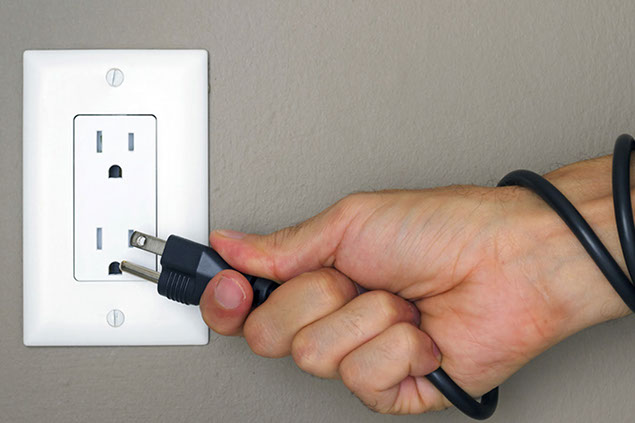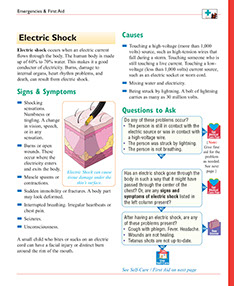CONDITIONS
SYMPTOM CHECKER
Male
Female
Child
Arm, Hand & Shoulder Concerns
Legs & Feet Concerns
Dental & Mouth Concerns
Ear & Nose
Eye Conditions
Head Conditions
Arm, Hand & Shoulder Concerns
Legs & Feet Concerns
Front
Back
Arm, Hand & Shoulder Concerns
Dental & Mouth Concerns
Ear & Nose
Eye Conditions
Head Conditions
Arm, Hand & Shoulder Concerns
Dental & Mouth Concerns
Ear & Nose
Eye Conditions
Head Conditions
Front
Back
Arm, Hand & Shoulder Concerns
Neck Links
Head & Neck Concerns
Arm, Hand & Shoulder Concerns
Neck Links
Head & Neck Concerns
Front
Back
Online Clinic
Wise Healthcare
Electric Shock
Print on Demand
RELATED ARTICLES
Electric shock occurs when an electric current flows through the body. The human body is made up of 60% to 70% water. This makes it a good conductor of electricity. Burns, damage to internal organs, heart rhythm problems, and death, can result from electric shock.
Eye Injuries & Irritation
Signs & Symptoms
• Shocking sensations. Numbness or tingling. A change in vision, speech, or in any sensation.
• Burns or open wounds. These occur where the electricity enters and exits the body.
• Muscle spasms or contractions.
• Sudden immobility or fractures. A body part may look deformed.
• Interrupted breathing. Irregular heartbeats or chest pain.
• Seizures.
• Unconsciousness.
A small child who bites or sucks on an electric cord can have a facial injury or distinct burn around the rim of the mouth.
Causes
• Touching a high-voltage (more than 1,000 volts) source, such as high-tension wires that fall during a storm. Touching someone who is still touching a live current. Touching a low-voltage (less than 1,000 volts) current source, such as an electric socket or worn cord.
• Mixing water and electricity.
• Being struck by lightning. A bolt of lightning carries as many as 30 million volts.
Treatment
Contact with electricity from a high-voltage wire or being struck by lightning needs emergency medical care. Contact with electricity from a low-voltage current needs emergency medical care if any signs or symptoms are present. A person who does not have any symptoms should still see a doctor to check for possible internal injuries.
To Avoid Being Harmed by Lightning
• Heed weather warnings.
• Take shelter in a building, if you can.
• Stay in your car (if it is not a convertible) rather than out in the open.
• If you are caught outside, avoid tall trees, open water, metal objects, and high ground. Crawl into a low-lying place or curl up on the ground, head to knees with your head touching the ground.
Questions to Ask
Question 1
Do any of these problems occur?
• The person is still in contact with the electric source or was in contact with a high-voltage wire.
• The person was struck by lightning.
• The person is not breathing.
Get medical care without delay. If symptoms are life threatening go to the ER or call 9-1-1. Don’t call 9-1-1 or use the ER if symptoms do not threaten life. Ask your doctor ahead of time where you should go for a problem that needs prompt care, but not emergency care.
Question 2
Has an electric shock gone through the body in such a way that it might have passed through the center of the chest? Or, are any signs and symptoms of electric shock present?
Get medical care without delay. If symptoms are life threatening go to the ER or call 9-1-1. Don’t call 9-1-1 or use the ER if symptoms do not threaten life. Ask your doctor ahead of time where you should go for a problem that needs prompt care, but not emergency care.
Question 3
After having an electric shock, are any of these problems present?
• Cough with phlegm. Fever. Headache.
• Wounds are not healing.
• Tetanus shots are not up-to-date.
You should be seen by your doctor for medical advice. Contact your doctor or health care provider to find out how soon you should be seen.
Use Self-Care / First Aid:
You can probably take care of the problem yourself if you answered NO to all the questions. Use the “Self-Care” measures that are listed. Call your doctor if you don’t feel better soon, though. You may have some other problem.
Self-Care / First Aid
Beware! Do not put yourself in danger to give first aid. Do not touch the person until power is shut off.
• If the source is a high-voltage wire or lightning, call 9-1-1!
• It is safe to touch a person struck by lightning.
• If the source is a low-voltage current, remove the fuse or switch off the circuit breaker to the electrical outlet.
• If you can’t shut off the source, with dry feet and hands, use a board, wooden stick, rope, etc. to get the person away from the source.
• If it is safe for you to touch the person, check for a response. Give CPR, as needed.
• Unless it is absolutely necessary, don’t move the person. He or she could have a traumatic injury, especially to the head or neck.
• Check for burns. Cover burned areas with dry, sterile dressings.
• Give first aid for Shock, if needed.
Prevention
• Stay clear of fallen wires. Inform the police, electric company, etc.
• Install ground-fault circuit-interrupters (GFCIs) in wall outlets of bathrooms, kitchens, etc. With GFCIs, when an electrical appliance falls into water, the current is instantly cut off.
• Don’t turn electrical switches on or off or touch an electric appliance while your hands are wet, while standing in water, or when sitting in a bathtub.
• Replace worn cords and wiring.
• Cover all electric sockets with plastic safety caps.
• Before you do electrical repairs, remove the fuse from the fuse box or switch off the circuit breaker. Don’t just turn off the appliance or light switch.
This website is not meant to substitute for expert medical advice or treatment. Follow your doctor’s or health care provider’s advice if it differs from what is given in this guide.
The American Institute for Preventive Medicine (AIPM) is not responsible for the availability or content of external sites, nor does AIPM endorse them. Also, it is the responsibility of the user to examine the copyright and licensing restrictions of external pages and to secure all necessary permission.
The content on this website is proprietary. You may not modify, copy, reproduce, republish, upload, post, transmit, or distribute, in any manner, the material on the website without the written permission of AIPM.
2021 © American Institute for Preventive Medicine - All Rights Reserved. Disclaimer | www.HealthyLife.com

















































